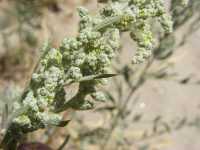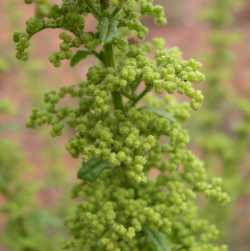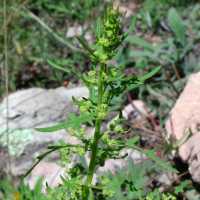Herbs, annual or short-lived perennials, covered with stalked glandular trichomes, sometimes in combination with subsessile glands and/or uniseriate multicellular trichomes, sometimes glabrescent (rarely farinose), usually aromatic (or malodorous to some people). Stems erect, ascending, decumbent, or prostrate, branched (rarely ± simple), not jointed, not spiny, not fleshy. Leaves alternate, petiolate (distal leaves sessile in sect. Adenois); blade linear, lanceolate, oblanceolate, ovate, or elliptic, often pinnately lobed, base cuneate to truncate, margins entire, dentate, or serrate, apex obtuse, acute, attenuate, or acuminate, mucronate. Inflorescences terminal, loosely flowering, simple or compound cymes or dense axillary glomerules; bracts absent, but glomerules often subtended by reduced leaves (sometimes referred to as 'leaflike bracts'). Flowers bisexual or rarely unisexual (at least functionally); perianth segments 1-5, connate basally to ± distinct, or fused to form sac surrounding fruit; stamens 1-5; ovary superior; styles 1-3, stigmas 1-3, filiform. Fruiting structures: achene often enclosed in perianth, pericarp adherent or nonadherent, membranaceous. Seeds horizontal or vertical, reddish brown or black, subglobose to lenticular; seed coat smooth to rugose; embryo annular or incompletely annular, surrounding copious farinose perisperm.
The generic name Dysphania traditionally was applied to seven to ten species endemic to Australia (P. Aellen 1930, 1930b; A. J. Scott 1978b; P. G. Wilson 1983, 1984, 1987). Placement and rank of this taxon have ranged from a mere section in Chenopodium (P. Aellen 1930, 1930b) to the sole genus of a separate family Dysphaniaceae, or a representative of Illicebraceae. Dysphania´s close affinity to 'glandular' species of Chenopodium sensu lato is now evident (P. Aellen 1930, 1933, 1960-1961; T. Eckardt 1964b, 1967, 1967b, 1968, [1969]; T. J. Mabry and H.-D. Behnke 1976; F. A. Pax and K. Hoffmann 1934b; A. J. Scott 1978b; P. G. Wilson 1983, 1984, 1987).
Here the genus Dysphania is accepted in an expanded circumscription (S. L. Mosyakin and S. E. Clemants 2002), including all other 'glandular' taxa previously treated in Chenopodium subg. Ambrosia A. J. Scott, or segregated in genera such as Roubieva Moquin-Tandon, Teloxys Moquin-Tandon, and Neobotrydium Moldenke. In its traditional circumscription Dysphania has no distinctive characters clearly separating it from those other 'glandular' chenopods.
Presence of glandular trichomes seems to be a character of high phylogenetic and taxonomic importance in Chenopodiaceae, in which types of trichomes were used for delimitation of genera, tribes, and even subfamilies. This character seldom fails, even if there are some parallel evolutionary trends present. R. C. Carolin (1983) suggested that Chenopodieae with glandular hairs probably separated from Chenopodieae with bladder hairs even at a more basal (earlier) phylogenetic level than the point of divergence of the latter from Atriplicinae. Chenopodium species with bladder hairs ('mealy chenopods') are probably more closely related to Atriplex and its satellite genera than to 'glandular chenopods.' P. G. Wilson (1984, 1987) came to the same conclusion.
W. A. Weber (1985) adopted the name Teloxys Moquin-Tandon for the group of 'glandular' taxa and transferred several species of 'glandular' Chenopodium to Teloxys. The latter was published simultaneously with Roubieva, and thus, if only these two generic names are considered, Weber´s choice should stand. However, the generic name Dysphania predates both Teloxys and Roubieva, and '...[I]f Teloxys, Orthosporum, and Dysphania are amalgamated then the oldest name Dysphania should be adopted' (P. G. Wilson 1987).







